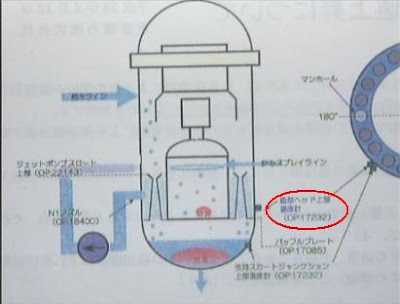TEPCO's Matsumoto opening remarks:
No Xe-135 detected in the latest gas sampling test.
Preparing to increase water.
1090 kilograms of boric acid solution has been poured into the RPV.
At 2:20PM, the temperature exceeded 80 degrees Celsius.
Since other temperatures at the bottom of the RPV remain low and the temperature of the Containment Vessel is not rising, the cold shutdown state remains.
(There are many reporters this time...)
It's the blue line in the chart (screen capture):
TEPCO thinks it is physically "very difficult" for the temperature to rise above 80 degrees Celsius, and it is likely to be the instrument failure.
No cesium-134 and 137 have been detected, so there is no steam being generated inside the RPV/CV.
Graph generated from the automatic digital reading showing 10 degrees "noise" starting 12 noon (before noon, the noise was 1 degree):
Asahi Shinbun's reporter asked how high exactly the temperature went, as the graph seemed to show the spike above 90 degrees Celsius.
Matsumoto answered the graph is plotting all the 1-second readings from the digital display, not visually verified by the workers. The official reporting is every 6 hours, the reference reporting is every hour.
Q: Will the amount of water be increased if the thermometer at that location continues to rise?
A: We will have to be careful. If the increased water doesn't lower the temperature, the instrument failure will be more likely.
Q: How to verify the instrument failure?
A: We want to do the resistance testing from the central control room.
Q: Why has the temperature started to vary widely since noon?
A: We don't quite know.
Q: When will you get back to the normal operation under the safety regulations?
A: To do it, we have to make sure it is the instrument failure.
Q: Does the instrument failure have to do with the variance?
A: It's not that the instrument failure started today, but it may have started late January when this thermometer started to behave differently from the other two at the bottom of the RPV. The 10 degrees Celsius water is right near the thermometer (15 centimeter away), and the thermometer shows rising temperature. The location of the thermometer should be uniformly cooled.
Q: Where do you measure the temperature of the water injected?
A: The temperature of the water is measured at the buffer tank. No place along the way to get heated.
Q: What happens if the temperature doesn't drop?
A: We will wait and see for a day.
Q: Why did you start mentioning "instrument failure" only when the temperature started to approach 80 degrees Celsius?
A: We didn't think it was behaving erratically. The variance of 1 degrees was understood. The trend changed at the end of January. Also, the temperature remained high as more water accumulate inside the RPV, therefore the instrument failure more likely.
A: We want to see if it is possible to have the instrument failure where the temperature drops, instead of going up.
A: The Containment Vessel is still hot and humid, so we have to make sure the other instruments are working properly. At this point, we don't have better alternatives.
9.9 (core spray, from 6.9) + 7.5 (feed water) = 17.4 tonnes/hour of water is to be injected into the RPV.
Q: Why are you increasing the amount of water if you think it is the instrument failure? What do you think of the safety regulations?
A: We have always informed the NISA and followed the safety regulations. (No answer on why they are increasing water.)
Q: Why did you pick this particular thermometer as the representative temperature for the RPV?
A: Perhaps it was one of the first to come back online last fall, but we will confirm.
Q: What happens if other thermometers fail?
A: We have to think about how to monitor the condition of the reactor, as we cannot enter the Containment Vessel.
(The press conference just finished. The above note is not necessarily comprehensive. In short, TEPCO thinks it is more likely to be the instrument failure, not the actual temperature rising, but it will continue to monitor the situation.)













 Tokyo Time
Tokyo Time
![[Most Recent Quotes from www.kitco.com]](http://www.kitconet.com/charts/metals/gold/t24_au_en_usoz_2.gif)

